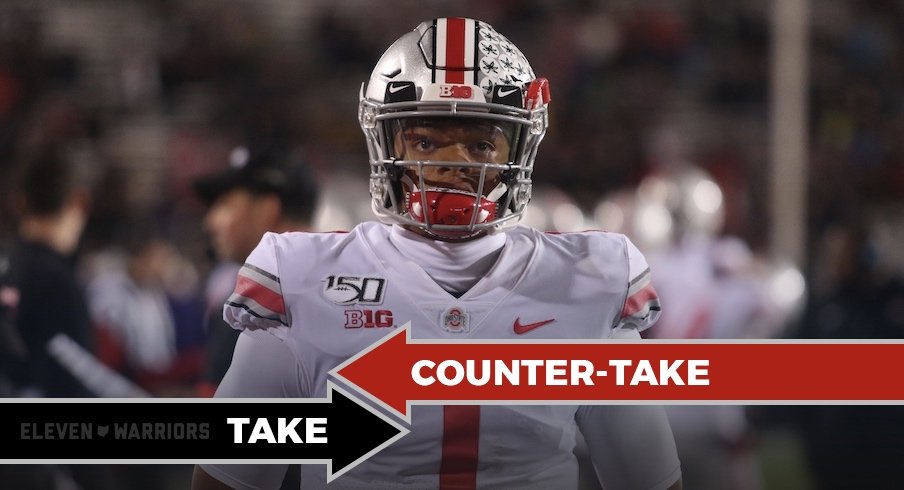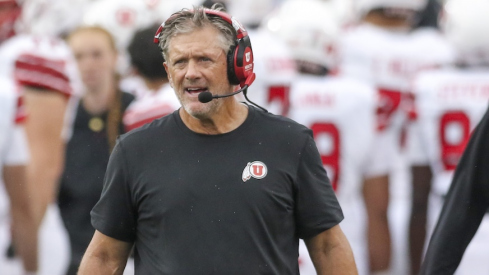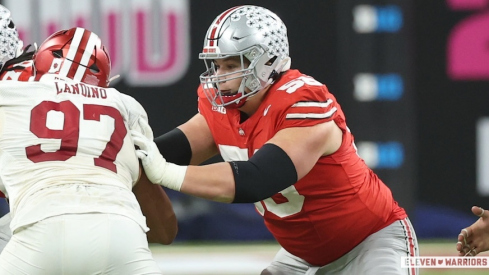Justin Fields only needed one year in Columbus to enter the Greatest Of All-Time conversation.
After transferring to Ohio State from Georgia, he ran the table in the regular season. Fields helped the Buckeyes pull off 12 straight double-digit-point victories, earning a trip to Indianapolis for a Big Ten title showdown with Wisconsin. Though the Buckeyes trailed at halftime, they pulled out the win to clinch a College Football Playoff bid, and Fields headed to New York City as a Heisman Trophy finalist.
After one year as a starter, is Fields already the best quarterback in Ohio State history? It's a worthy debate.
Take: Justin Fields is Ohio State's best quarterback ever
Kyle Jones: Throughout Ohio State's illustrious history, there have been many great players to line up under center. There have been some outstanding passers (Art Schlichter, Joe Germaine, Dwayne Haskins), some who succeeded due to their athletic ability (Terrelle Pryor, Braxton Miller), and a handful who earned the title of "winner" due to their determination and leadership (Rex Kern, Troy Smith, J.T. Barrett).
While a couple of the great players mentioned above may have qualified for multiple categories, only Justin Fields and Troy Smith could be considered for all three. Smith, of course, is the only QB to ever bring a Heisman Trophy back to Columbus, yet Fields eclipsed every metric of Smith's in just his sophomore season.
In both Smith's 2006 season and Fields' 2019 campaign, a bevy of talented playmakers surrounded each quarterback, providing a myriad of weapons at their disposal while multiple future NFL draft picks protected them in the pocket. Yet Fields surpassed Smith in every category, and from a statistical perspective, it's really not that close.
As runners, the two put up comparable numbers, as Fields tallied 10 rushing touchdowns last fall while Smith found the end zone 11 times in 2005, his first full season as a starter (but one in which he threw just 16 touchdown passes). Fields' 51 total touchdowns (rushing and passing) in 2019 far surpasses any such total put up by Smith in his three years of playing time and is only matched by Haskins.
| Year | Games | Completions | Attempts | Comp. % | Pass Yds | Yds/Attempt | TDs | INTs | Rating | |
|---|---|---|---|---|---|---|---|---|---|---|
| Troy Smith | 2006 | 13 | 203 | 311 | 65.3 | 2,542 | 8.2 | 30 | 6 | 161.9 |
| Dwayne Haskins | 2018 | 14 | 373 | 533 | 70.0 | 4,831 | 9.1 | 50 | 8 | 174.1 |
| Justin Fields | 2019 | 14 | 238 | 354 | 67.2 | 3,273 | 9.2 | 41 | 3 | 181.4 |
Make no mistake, Haskins was marvelous in his lone season as a starter for the Buckeyes. He shattered nearly all of the single-season and game passing records as Ohio State firmly abandoned its well-earned identity as a ground-and-pound system and embraced an aerial-first attack.
But to use volume stats to compare the two would simply be unfair. In 2018, Haskins threw 30+ passes 12 times, while Fields surpassed that mark just twice the following year. Though he had fewer opportunities, Fields was more efficient than Haskins had been, finishing with a higher yards-per-attempt average, fewer interceptions, and a better overall QB rating.
While it's fair to argue that Fields benefited from playing opposite an elite defense which led to him spending many fourth quarters watching from the sidelines (a luxury not afforded to Haskins), it must also be pointed out that Fields' team was far more effective in the red zone, as nine of his TD runs came from inside the opposing 20.
With Fields leading the charge, the Buckeyes scored touchdowns on 78.7% of their trips to the red zone, the fourth-best total in the nation last year. With Haskins' relative lack of mobility the year prior, OSU only found the end zone on 61.4% of the time in such scenarios, with Tate Martell even spelling the QB on a few occasions in hopes of providing a short-yardage spark.
Though Haskins may have been outstanding in many regards, I can't in good faith call him the best QB in school history when a now-backup wide receiver for the University of Miami replaced him in order to increase the team's scoring chances. Meanwhile, Fields is the total package and did all this just 18 months after his high school prom, meaning we're likely just scratching the surface of his true potential.
Counter-Take: Justin Fields is not the best quarterback to ever play for Ohio State
Jake Anderson: Debating the "best of all time" can be an exhausting task. Did you see Twitter during the Michael Jordan documentary? It felt like a war between Jordan and LeBron fans under every sports-related tweet.
In typical Buckeye fanaticism and in the spirit of my recent obsession with rankings, the discussion of the best Ohio State quarterback ever has become the new frontier. And after just one season in Columbus, Justin Fields has already earned every right to be in the conversation for this title. But he has not won the crown. Not yet, anyway.
Fields' 2019 season was filled with impressive efficiency and versatility. He threw for nearly 3,300 yards, completed over 67 percent of his passes and threw just three interceptions. His team won 13 games, including an undefeated regular season, and he was a Heisman finalist.
He was also a member of one of the most talented Buckeye teams of all time. The offense had playmakers all over the field, the line was chocked full of talent, and the defense had three first-round picks. Fields should not be punished for elevating his talented counterparts and first-year head coach, but the context of his season should be well-understood before diving into the highs and lows of the other quarterbacks in this conversation, one of which is Dwayne Haskins.
The redshirt sophomore started his 2018 season by beating out a future Heisman Trophy winner for the starting position. That Heisman winner would be nearly unanimous, breaking a record held by another Buckeye legend (more on him later).
On a team lauded for its skill players and defensive front before the season, the Buckeyes stumbled for most of the season with only Haskins to save them.
This is the stupidest team Ive ever seen in my life.
— Ramzy Nasrallah (@ramzy) October 21, 2018
In all locations other than Ross-Ade Stadium, he did. Whether it was against Penn State in which the rushing game averaged 3.2 yards a pop or against a Maryland team that scorched the Buckeye defense for 51 points, Ohio State's first-year starter stepped up to the challenge.
While Fields could rely on Dobbins to take some of the pressure off of him in big games, Haskins had no such safety valve; the Buckeyes averaged 4.2 yards per carry in 2018, the worst mark since 2004. Teams were able to hone in on Haskins, focusing on the passing game while knowing that the running backs would not be able to break free.
When comparing the two on a basic level, it is obvious that Fields is outmatched by Haskins. The first-round pick and 2018 starter holds nearly every program and conference passing record, out-gaining the Georgia transfer by more than 1,500 passing yards while completing nearly 3 percent more of his passes. Fields holds a slight advantage in yards per attempt and passer rating.
It is not always about the stats, though. Jones, being an X-and-O guru, would probably love to point out a number of throws that supposedly prove that Fields is an undeniably better thrower than Haskins. To that, I wholeheartedly disagree.
As discussed earlier, teams were scared of Ohio State's offense not just because of the quarterback, but because of Dobbins. As the school's only 2,000-yard rusher, he put pressure on teams in a way that he and Mike Weber could not in 2018.
While the two are both on the Mount Rushmore of Ohio State quarterbacks, Fields' efficiency in his first season is not quite enough to push him over Haskins' carrying of the offense in 2018.
Then, of course, we have Troy Smith. Smith does not have the numbers to compare to the 2019 and 2020 starter, but he has the accolades. The 2006 Heisman Trophy winner earned nearly 91 percent of the first-place votes, a testament to his dominant season, and the No. 1 spot in the BCS rankings after the regular season and a huge win over No. 2 Michigan.
Comparing players from different eras is always difficult for "best of all time" discussions, and the 13 years of college football separating Smith and Fields might as well be 13 decades. Since 2006, the sport has seen an unprecedented change in offensive and defensive philosophy, leading to more passing and greater production.
Despite being stuck in Tressel-ball, Smith recorded two of the five best passing seasons in Ohio State history. Smith was the most dominant force of his time and, while likely not as talented as Fields on a pure passing basis, deserves the title as much or more so than the Georgia transfer.
Fields came to Ohio State as the highest-rated player in the recruiting ranking era and he lived up to the hype. He is undeniably talented and should be the favorite for the 2020 Heisman Trophy. I have little doubt that his upcoming season will sway my opinion on this subject in his favor, but for now, Fields will have to settle for bronze.


